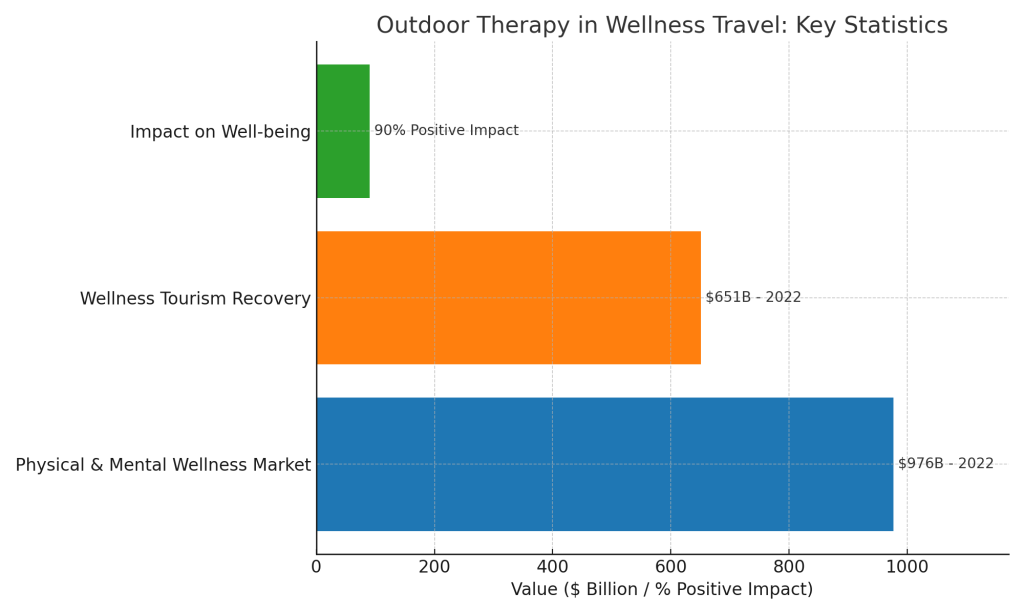In recent years, there has been a noticeable shift in the way people approach wellness travel. As the stresses of modern life continue to mount, individuals are increasingly seeking solace in the natural world, turning to outdoor therapy as a means of rejuvenation and healing. This trend marks a departure from traditional spa retreats and resort vacations, highlighting a growing recognition of nature’s profound impact on mental, emotional, and physical well-being.
Let’s explore its roots, benefits, and the myriad ways in which it is transforming the landscape of wellness travel.
Understanding Outdoor Therapy
The Origins of Outdoor Therapy
The concept of using nature as a therapeutic tool is not new. Indigenous cultures around the world have long recognized the healing properties of the natural environment, incorporating elements such as forest bathing, wilderness retreats, and nature-based rituals into their healing practices. However, it was not until the late 19th and early 20th centuries that outdoor therapy began to gain traction in Western medicine.
Pioneers such as Dr. William James and Dr. William Bird were instrumental in popularizing the idea that exposure to nature could have profound effects on mental and physical health. Their research laid the groundwork for modern approaches to outdoor therapy, paving the way for its integration into contemporary wellness practices.
Defining Outdoor Therapy
Outdoor therapy, also known as ecotherapy or nature therapy, encompasses a range of therapeutic interventions that take place in natural settings. These may include activities such as hiking, camping, gardening, wildlife observation, and adventure sports, among others. The underlying principle is simple yet profound: by immersing oneself in nature, individuals can tap into its restorative powers and enhance their overall well-being.
The Benefits of Outdoor Therapy
Mental Health Benefits
One of the most well-documented benefits of outdoor therapy is its positive impact on mental health. Studies have shown that spending time in nature can reduce symptoms of stress, anxiety, and depression, while also improving mood and cognitive function. The tranquility of natural settings provides a welcome respite from the constant stimulation of modern life, allowing individuals to quiet their minds and reconnect with themselves on a deeper level.
Physical Health Benefits
In addition to its mental health benefits, outdoor therapy can also have significant effects on physical well-being. Regular exposure to natural sunlight helps regulate circadian rhythms and vitamin D levels, which are essential for maintaining overall health. Furthermore, activities such as hiking, biking, and swimming provide excellent opportunities for cardiovascular exercise, muscle strengthening, and stress reduction, contributing to improved physical fitness and resilience.
Social and Emotional Benefits
Outdoor therapy is not just about individual healing; it also fosters a sense of connection and community. Whether participating in group hikes, eco-retreats, or conservation projects, individuals have the opportunity to bond with others who share their appreciation for the natural world. These social connections can provide vital support networks, reduce feelings of isolation, and enhance overall emotional well-being.
The Rise of Outdoor Therapy in Wellness Travel
Changing Trends in Wellness Travel
As the demand for authentic and transformative travel experiences continues to grow, traditional spa resorts and beach destinations are no longer enough to satisfy discerning travelers. Instead, there is a rising interest in immersive and experiential journeys that prioritize holistic well-being and personal growth. Outdoor therapy aligns perfectly with this shift, offering travelers the opportunity to explore new landscapes, engage in meaningful activities, and cultivate a deeper connection with themselves and the world around them.
Destinations and Retreats
From rugged mountain ranges to pristine coastal beaches, the world is teeming with destinations that cater to outdoor enthusiasts and wellness seekers alike. Whether embarking on a wilderness expedition in Patagonia, practicing yoga amidst the serene forests of Bali, or embarking on a mindful meditation retreat in the Himalayas, there are endless possibilities for those looking to incorporate outdoor therapy into their travels.
Tailored Experiences
In response to growing demand, many tour operators, retreat centers, and wellness resorts are now offering tailored experiences that combine outdoor adventure with therapeutic practices. These may include guided nature walks, meditation sessions, wildlife encounters, and outdoor workshops led by experienced practitioners. By curating immersive and holistic itineraries, these providers empower travelers to embark on transformative journeys of self-discovery and personal growth.

The Statistical Backbone of Outdoor Therapy in Wellness Travel
Physical and Mental Wellness Market Trends: According to The Global Wellness Institute, the global physical activity market was estimated at $976 billion in 2022, showing a rapid rebound post-pandemic, highlighting an increased return to outdoor activities and exercise routines. The mental wellness market also experienced significant growth, reaching $181 billion in 2022. This growth underlines a broader trend towards prioritizing physical and mental health through activities that often involve nature and outdoor experiences.
Wellness Tourism Recovery and Projections: Wellness tourism, deeply impacted by the pandemic with expenditures plummeting to $351 billion in 2020, has shown a resilient recovery, reaching $651 billion in 2022. The sector is projected to grow by 16.6% annually, potentially hitting $1.4 trillion by 2027. This recovery and projected growth signify a strong and increasing demand for travel experiences that focus on personal well-being, where outdoor therapy plays a significant role.
The Impact of Outdoor Activities on Well-being: Outdoorsy’s survey highlights the profound benefits of spending time outdoors, with more than 90% of North Americans stating it makes them happy and improves their overall mental health. The survey also emphasizes the social and emotional benefits of outdoor activities, with significant numbers of respondents preferring to engage in these activities with others, reinforcing the idea that outdoor therapy not only benefits individual well-being but also strengthens social bonds and community.
These statistics and insights emphasize the growing recognition of nature’s role in enhancing physical, mental, and social well-being, which is driving the popularity of outdoor therapy in wellness travel.
Must-read: The Rise and Benefits of Calm-cations in 2024
Overcoming Barriers to Access
While outdoor therapy holds tremendous promise as a tool for wellness and healing, it is essential to acknowledge and address the barriers that may prevent certain individuals from accessing these experiences. Factors such as physical disabilities, socioeconomic constraints, and geographical limitations can pose significant challenges for those seeking to engage in outdoor activities. To ensure inclusivity and accessibility, it is crucial for providers to offer a diverse range of options, accommodate special needs, and work towards creating more equitable opportunities for all.
Frequently Asked Questions (FAQs) Not Covered in the Article
- What is the difference between ecotherapy and outdoor therapy?
- Ecotherapy and outdoor therapy often overlap but may have nuanced differences based on the therapeutic approach and the emphasis on ecological conservation.
- Can outdoor therapy be beneficial for children and adolescents?
- Investigates how outdoor therapy specifically supports developmental needs, emotional growth, and social skills in younger populations.
- How do urban green spaces contribute to outdoor therapy?
- Explores the role of parks, gardens, and green corridors within cities in providing therapeutic benefits and accessibility to nature.
- What are the credentials or qualifications for outdoor therapy practitioners?
- Details on the training, certification, and professional standards required to lead therapeutic activities in outdoor settings.
- How does outdoor therapy integrate with traditional mental health treatments?
- Discusses how outdoor therapy complements conventional therapies like cognitive-behavioral therapy (CBT) or medication.
- What are the environmental impacts of increasing outdoor therapy activities?
- Considers the sustainability and ecological footprint of outdoor therapy practices, especially in sensitive or protected natural areas.
- How can individuals with physical disabilities participate in outdoor therapy?
- Information on adaptive equipment, accessible trails, and inclusive programs designed to make outdoor therapy available to everyone.
- What research supports the efficacy of outdoor therapy?
- Summarizes key studies and scientific evidence highlighting the therapeutic outcomes of nature-based interventions.
- How do cultural differences influence the practice of outdoor therapy?
- Examines how outdoor therapy is adapted or varies across different cultural contexts and traditions.
- Are there any contraindications or situations where outdoor therapy might not be recommended?
- Discusses scenarios or conditions where outdoor therapy might need to be approached with caution or adapted for safety.
Conclusion
Nature’s healing power is undeniable. From the tranquil beauty of a forest glade to the awe-inspiring majesty of a mountain summit, the natural world has the ability to soothe our souls, uplift our spirits, and restore our sense of balance and harmony.
As the popularity of outdoor therapy continues to rise, it is poised to revolutionize the way we approach wellness travel, offering travelers the opportunity to embark on transformative journeys of self-discovery and renewal.










